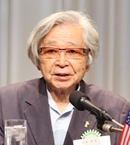Making Films
September 11, 2013
Mr. Yoji Yamada
Film Director
 ��I would like to share with you two topics regarding movies today. Let me start by asking how often you go to cinemas to watch movies, especially Japanese movies. Some of you may be frequent moviegoers, while some may not have seen movies for many years.
��I would like to share with you two topics regarding movies today. Let me start by asking how often you go to cinemas to watch movies, especially Japanese movies. Some of you may be frequent moviegoers, while some may not have seen movies for many years.
��I am sure many of you are familiar with the 1953 film ��Tokyo Story�� directed by Yasujiro Ozu. My first topic is about Mr. Ozu whose international fame has recently risen rapidly. Japanese directors Akira Kurosawa and Kenji Mizoguchi already enjoyed worldwide fame in the 1950s, especially in Western countries. The reputation of Mr. Ozu, however, continued to grow especially in Europe after his death in 1963.
��The British Film Institute (BFI) is the oldest and the most authoritative film center in the world founded in the 1930s. BFI launched its ��10 Greatest Films of All Time�� initiative in the 1950s, which became a decennial event that selects the top 10 movies from around the world. This event attracts much attention as the movies are chosen by voting from the world��s prominent movie directors and critics. Works of Mr. Kurosawa and Mr. Mizoguchi have been chosen several times that invigorated the Japanese film industry. To our great surprise and delight, ��Tokyo Story�� by Mr. Ozu ranked third in the Critics�� Top 250 Films for the first time in 1992. To our even greater surprise, ��Tokyo Story�� was selected as the Greatest Film of All Time in the 2012 Poll of Directors�� Top 100 Films. We can all be proud of this remarkable achievement to be selected the world��s best movie among numerous works produced over the century. If I may add, ��2001: A Space Odyssey�� by Stanley Kubrick won the second place, followed by ��Citizen Kane�� of Orson Welles and ��8 1/2�� by Federico Fellini. I am deeply impressed that ��Tokyo Story�� has won the decade-long title over the world��s most influential directors.
��Another point to note is ��Tokyo Story�� is a black and white monaural movie made 60 years ago at a modest production cost. It depicts the humble daily life of ordinary citizens in a rather detached tone. The screen size is small and its sound quality is far from being superior. Compared with other movies based on grand-scale scripts and enormous production costs, ��Tokyo Story�� is a small-scale movie made when Japan was still suffering postwar poverty. I am deeply impressed that movie directors and critics around the world chose this movie as the best at this time.
��It goes without saying that the world has changed dramatically since Mr. Ozu��s time, so has the expressive medium of movies. This brings me to the second topic I wish to share today. The movie industry is making drastic changes. For example, moving picture films started disappearing in the last couple of years, as they are being replaced by digital equipments. ��Star Wars�� and ��Jurassic Park�� made the news with their extensive use of CGI (Computer Generated Imagery). Back then, images shot on moving picture films were put into database for CG processing, then put back into films to be shown at cinemas. This rather time-consuming process was replaced by the quickest way of using CG cameras from the outset. An increasing number of movies with CGI are being made today.
��The introduction of digital cameras for filming has encouraged image projection on to the screen in digital formats, without using the traditional film projectors. The Japanese movie industry has digitalized dramatically over the past years, along with the development of digital technologies of an unprecedented scale that marks a historic milestone.
��Digital technologies have improved convenience and efficiency of film making, yet I must question whether such technologies have brought a new medium of expression. How effective digital technologies serve to improve the quality of works remains obscure.
��To be honest, I prefer using moving picture films both for filming and screening. I believe films give a more natural skin tone and it makes me feel much more comfortable. That is why I used films to shoot my latest work ��Chiisai Ouchi (Small House)�� and I am also planning to take my next work by films. From now on, you will probably watch my movies taken by films and then put into digital for screening at cinemas. It might not take long before films disappear from the movie industry, and so I want to express my sincere gratitude to moving picture films that supported my career as a movie director. Being a big fan of films, I also wish film manufacturers and laboratories will stay in business as long as they could.
��As I close my speech, let me touch upon my latest work ��Chiisai Ouchi�� that depicts human relations and events during the pre-War times set in the Showa era. I sincerely hope the younger generation will come to watch the movie and discover something new.